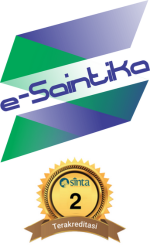Analysis of Students' Critical Thinking Improvement in Teaching Inquiry with Cognitive Conflict Strategies
Abstract
Keywords
Full Text:
PDFReferences
Ambrose, S., & Lovett, M. (2014). Prior knowledge is more than content: Skills and beliefs also impact learning. Applying Science of Learning in Education, 1(2), 7-19.
Arends, R. I. (2012). Learning to teach (9th edition). New York: McGraw-Hill.
Chinn, C. A., & Malhotra, B. A. (2002). Children’s responses to anomalous scientific data: How is conceptual change impeded? Journal of Educational Psychology, 94, 327-343.
Chinn, C. A., & Brewer, W. F. (1998). An empirical text of a taxonomy of responses to anomalous data in science. Journal of Research in Science Teaching, 35(6), 623-654.
Dolezal, S. E., Welsh, L. M., Pressley, M., & Vincent, M. M. (2003). How nine third-grade teachers motivate student academic engagement. Elementary School Journal, 103, 239-267.
Ennis, R. H. (1991). Critical thinking: A streamlined conception. Teaching Philosophy, 14(1).
Facione, P. (1991). Critical Thinking: A statement of Expert Consensus for Purposes of Educational Assessment and Instruction. The California Academic Press.
Fine, M. & Desmond, L. (2015). Inquiry-based learning: Preparing young learners for the demands of the 21st century. Educator’s Voice, VIII, 2-11.
Hake, R. R., (1999). Analyzing Change/Gain Scores. Retrieved from ).
Hamlin, M., & Wisneski, D. (2012). Supporting the scientific thinking and inquiry of toddlers and preschoolers through play. Young Children, 67(3), 82-88.
Kemendikbud. (2013). Pendekatan Scientific (Ilmiah) dalam Pembelajaran. Jakarta. Pusbangprodik.
Kwaku, A. G., Barker, R., Berry, C., & Brown, C. (2014). Instructional strategy lessons for educators secondary education (ISLES-S). East Carolina University.
Limon, M., & Carretero, M. (1997). Conceptual change and anomalous data: A case study in the domain of natural sciences. European Journal of Psychology of Education, 12(2), 213-230.
Pintrich, P. R. (1999). Motivational beliefs as resources for and constraints on conceptual change. In W. Schnotz, S. Vosniadou, dan M. Carretero (Eds.). New perspectives on conceptual change (pp. 33–50). Amsterdam: Pergamon.
Pintrich, P. R., Marx, R. W., & Boyle, R. A. (1993). Beyond cold conceptual change: The role of motivational beliefs and classroom contextual factors in the process of conceptual change. Review of Educational Research, 63(2), 167-200.
Prayogi, S., Yuanita, L. & Wasis. (2018). Critical-Inquiry-Based-Learning: A model of learning to promote critical thinking among prospective teachers of physic. Journal of Turkish Science Education, 15(1), 43-56. doi: 10.12973/tused.10220a
Prayogi, S., Yuanita, L. & Wasis. (2017). Critical-Inquiry-Based-Learning: Model of learning to promote critical thinking ability of pre-service teachers. Journal of Physics: Conference Series 947, 1-6. doi: 10.1088/1742-6596/947/1/012013
Rodger W.B, Joseph A.T, April G, Pamela V.S, Janet C.P, Anne W, and Nancy L. (2006). The BSCS 5E Instructional Model: Origins and Effectiveness. Report by Science Education National Institutes of Health.
Samarapungavan, A., Mantzicopoulos, P., & Patrick, H. (2008). Learning science through inquiry in kindergarten. Science Education, 92(5), 868-908.
Thompson, C. (2011). Critical thinking across the curriculum: Process over output. International Journal of Humanities and Social Science 1(9).
DOI: https://doi.org/10.33394/j-ps.v9i1.3999
Refbacks
- There are currently no refbacks.
Copyright (c) 2021 Ni Nyoman Sri Putu Verawati, Hikmawati Hikmawati

This work is licensed under a Creative Commons Attribution 4.0 International License.

J-PS (Prisma Sains: Jurnal Pengkajian Ilmu dan Pembelajaran Matematika dan IPA IKIP Mataram) p-ISSN (print) 2338-4530, e-ISSN (online) 2540-7899 is licensed under a Creative Commons Attribution 4.0 International License.








 https://orcid.org/0000-0003-4395-5221
https://orcid.org/0000-0003-4395-5221